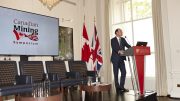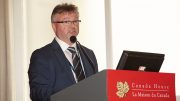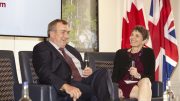With 11 of 13 First Nations reaching settlements on land claims and a new gold mine set to ramp up production, Yukon was the focus of discussion during the Territorial Panel at The Northern Miner’s annual Canadian Mining Symposium held at Canada House in London, U.K., earlier this year.
The panel consisted of Yukon Premier Sandy Silver; Graham Downs, president and CEO of ATAC Resources (TSXV: ATC); Brandon Macdonald, president and CEO of Fireweed Zinc (TSXV: FWZ); John McConnell, president and CEO, Victoria Gold (TSXV: VIT); and Paul West-Sells, president and CEO of Western Copper and Gold (TSX: WRN; NYSE-AM: WRN); with Andrew Cheatle, senior vice-president for Africa with Forbes & Manhattan, as the panel moderator.
The companies on the panel are all part of the Yukon Mining Alliance, a government-industry initiative designed to promote investment in the territory.
Premier Silver kicked things off by offering the audience some facts and perspective on the Yukon in Canada’s northwest.
Silver referred to the territory as “British Columbia’s hat,” and said it is the size of the U.K., but with a population of just 41,000. The airport in Whitehorse, the capital, hosts daily flights from Vancouver and Germany (mid-year), and is one of 28 government-maintained airports and aerodomes there. Yukon also has three ice-free, deepwater ports that Silver noted are four days closer by ship to Asian markets than Vancouver.
The premier boasted that the Yukon is among the top-10 jurisdictions on the Investment Attractiveness Index in the Fraser Institute’s 2018 annual survey of mining companies, up three spots from the previous year’s edition.
“There are many reasons for that. We have significant geological potential. The Yukon Geological Survey provides the public with geological data for over 2,700 geological mineral occurrences in the territory. This data provides the baseline for many of tomorrow’s discoveries. Natural Resources Canada estimates that Yukon hosted 8% of Canada’s exploration and deposit appraisal activity in 2018,” Silver said.
He added: “We have very strong government-to-government relations with our Indigenous communities. We have made investments in infrastructure. There is political stability and regulatory clarity, as well.”
The biggest investment in infrastructure comes in the form of the Yukon resource gateway project, a $500-million investment by the federal and territorial governments, as well as industry, to essentially build three roads into areas where there is high mineral potential.
“Your regulatory regime and ease of permitting do not matter if there is no mineral endowment,” Macdonald said. “The Yukon has already demonstrated significant mineral endowment potential and incredible prospects for more.”
Downs added: “The world is getting smaller and smaller, and it’s getting harder and harder to find deposits in friendly jurisdictions. With the rich history of mineral exploration and placer mining in the Yukon, it’s a welcome place to find new deposits. Just the fact that we found Canada’s only Carlin-style mineralization in 2010 shows you how much potential there is to find new deposits in the Yukon.”
Cheatle then asked panel members to comment on some of the measures taken by the territorial government to make Yukon more attractive for mineral exploration.
“One of the knocks against the Yukon is that people are worried about the infrastructure,” West-Sells said. “If you look at the area where we are, within a 50 km radius, there are 25 million oz. gold in resource, and that’s where two of these roads are going.”
One of Yukon’s biggest success stories to date is Victoria Gold. The junior is building the Eagle gold mine, which is scheduled to pour its first gold in September.
The project hosts a National Instrument 43-101 compliant reserve of 123 million tonnes grading 0.67 gram gold for 2.7 million oz. gold, with potential to boost that amount with further exploration. McConnell said the jurisdiction played a significant role in securing financing to build the Eagle mine.
“Victoria is the poster child for investment in the Yukon. We acquired the property in 2009. Between 2009 and 2018, we were able to raise more than $150 million to move the project through exploration, a feasibility study and permitting. And then we were able to raise $500 million to build the mine. People looked at the jurisdiction very favourably,” McConnell said. “Groups like Orion Mine Finance and Osisko Gold Royalties (TSX: OR; NYSE: OR) made big bets on Victoria Gold and our team to execute, but they paid close attention to the jurisdiction.”
Silver also emphasized his government’s relationship with Indigenous communities, which he notes are underpinned by “constitutionally protected modern treaties” and self-governing agreements that provide both sides with a legal framework from which to make decisions, and determine how to best use the territory’s resources.
Macdonald, who grew up in the community of Ross River, talked about his experience with the Ross River Dena Council First Nation.
“When you’re working on a project and you spend so much time in the community and the community has such a small population, you can’t help but get to know people. That helps build solid relationships (with First Nations), because it’s not something that you can just drop in on, have your meeting and not worry about it again until you have your next meeting. [There’s] a perpetual need to engage … whether you’re driven by moral imperative or financial imperative, you have to have those relationships,” Macdonald said.
McConnell echoed Macdonald.
“We have a great relationship with the First Nation we work with. I can honestly say many of the First Nations members are friends. I own a home in the community so I spend a lot of time there, and we continually work on our relationship,” he said.
At that point, Cheatle moved the discussion toward land-claim settlements and Yukon’s unique position in Canada.
“Eleven out of the 13 [Yukon] First Nations have settled land claims. That means when you’re developing a project there are boundaries. It’s clear in terms of the First Nations that you need to engage and consult with,” West-Sells said. “The other part is that when you enter the regulatory phase, the environmental assessment, the First Nations are fully scoped into that assessment. The way that the First Nations are woven into the environmental assessment process in the Yukon is unique to Canada. It gives you some certainty, as compared with other areas, where you don’t have those settlements with First Nations.”
ATAC Resources is developing the Rackla gold property in the Yukon, and has been operating there for 10 years. During that time, Downs said his company has worked extensively with First Nations.
“We have exploration cooperation agreements [with First Nations]. We were either the first or second group that has done a joint-decision document working with a First Nation on settlement lands with a potential road route. That’s really exciting. It’s about asking questions like: ‘Is this something you want to do?’ or ‘Can we work with you?’”
Andrew Cheatle asked panelists if they had anything to say to the premier, given that he was on the panel.
West-Sells and Macdonald suggested improvements to the regulatory framework to make things move faster. Downs said that while the government has made significant infrastructure improvements, ATAC still has ongoing infrastructure needs. Everyone agreed that Silver was quite accessible and rarely more than a phone call away.
Indeed, Premier Silver even married McConnell and his wife less than a year ago.
Perhaps the most glaring problem in the Yukon is the lack of available labour. Silver said Yukon has the lowest unemployment rate in Canada.
To that end, Victoria Gold has launched a labour recruitment campaign with the tagline: “Yukoners, it’s time to come home,” as part of an effort to lure miners who left the Yukon to find work at mines in other jurisdictions.
When Cheatle asked why the premier spends so much time on mining-related initiatives, Silver said: “As goes mining, so goes the Yukon.”






Be the first to comment on "‘As goes mining, so goes the Yukon’: Government and corporate leaders on territory’s potential"